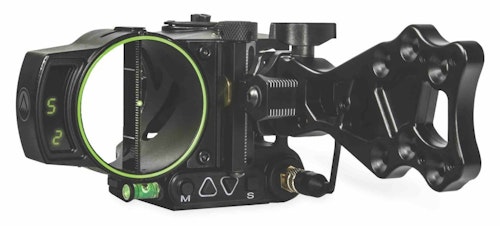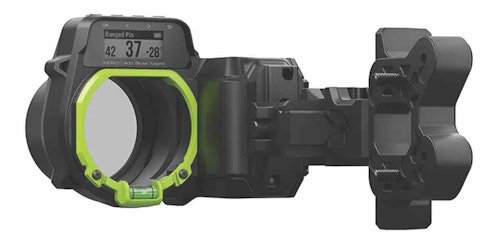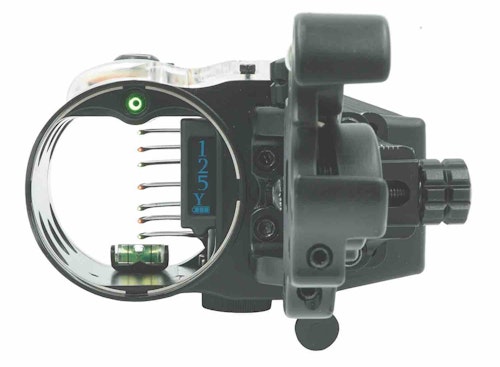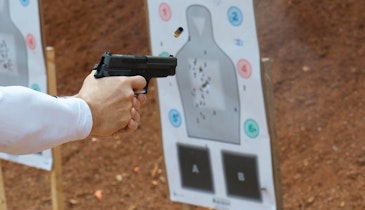It seems like only yesterday brass pins or fine wire crosshairs were the cutting-edge technology in bowsights. Fast-forward 25 years and the newest technology not only measures the distance to your target for you, but also provides a dot in your sight window for the exact shooting distance. In terms of technology, these sights are nothing short of amazing; however, they are more complex than a regular bowsight. Still, some bowhunters may be intimidated by them, not to mention they are also quite expensive. That said, thanks to hunters who crave the latest and greatest technology, these bowsights will no doubt keep growing in popularity.
Here are a few current options to consider for your customers who are interested in a rangefinding bowsight.
Burris Oracle
At the 2019 ATA show, Burris Optics released their new Oracle laser rangefinding sight. The Oracle, with the touch of a button, ranges targets; however, the Oracle sight is capable of ranging deer out to 200 yards and reflective targets out to 500 yards.
In the case of the Oracle sight, the ranged distance is displayed via LED lights within the sight housing. The Oracle does not have glass covering the sight window. Instead, it has a thin, solid post that runs vertically through the entire sight window. The proper aiming spot lights up for the ranged distance. The Oracle also has a built in inclinometer to compensate for shot angles either up or down.
This sight also has a quiet and simple push button that is easily installed on the front grip area, customized to the individual archer can easily range without unnecessary movement. The bubble level system is like most of today’s bowsights where there is simply a level installed on the bottom of the sight window.
A unique feature of the Oracle is the rear sight, which mounts on the back of the sight. This aids with a few things. First, it eliminates the need for a peep in your string, and that in itself drastically improves low-light shooting. With the rear sight installed, you can also see inconsistency and poor form like grip torque. In turn, the sight helps combat those issues.
The Oracle also has a built-in 20-yard fixed pin. Set up of the sight requires the use of this pin, but it is also always there. This means if the bowsight fails or the battery dies, there is always a 20-yard pin.
Compatible with arrow speeds from 200 to 420 fps, the Oracle will store two different trajectory curves for different arrows and/or draw weights. Made from an aluminum housing, the sight weighs 17 ounces. It also has second and third axis adjustments and has locking micro-adjust knobs for tuning the sight. The sight can also be easily adapted for a right- or left-handed shooter. The bowsight runs on CR123 batteries and 1,000 to 2,000 activations can be expected per battery.
MSRP: $830
CONTACT: www.burrisoptics.com
Garmin Xero A1i
Two years ago Garmin stole the show at ATA in Indianapolis with the release of the Xero A1 sight. Their new Xero A1i is an improved version of the original with a couple of great new features.
The A1i provides the shooter with an angle-compensated laser-ranged distance out to 100 yards and out to 300 yards on reflective targets. This can be done either at full draw or at rest, which virtually eliminates having to carry a separate rangefinder. Once your sight provides a range to your target, the sight then automatically displays an LED aiming point to use for the shot.
The silent button trigger is installed on the front of the bow handle where the hand rests naturally for quickly and quietly ranging targets with minimal movement. The Xero A1i also has a great leveling system. Blinking lights let a shooter know if the bow is level or canted. If the top pin is blinking, the bow is canted to the right; if the bottom pin is blinking, the bow is canted to the left.
The sight does project the pins onto a glass lens, but the lens is unmagnified. The target side of the lens is glass that is water repellent, anti-reflective and easily cleaned. The archer side is water-repellent, easy-clean glass but is 20 percent reflective. There is not any light projected toward the target at any time. Individuals can choose between green and red projected pins. Pin brightness is automatically set via the onboard ambient light sensor or can also be done manually. Shooters can also set a stack of fixed LED pins similar to a multi-pin sight, too. This stack can be moved up or down within your window for each individual archer’s needs.
The biggest improvement over the original Xero A1 is the ability to load up to 10 different arrow profiles within it. Meaning, you can sight-in several different arrows each designed for a specific purpose (e.g. 3-D, fixed-blade and mechanical broadhead) and then just toggle to the arrow of your choosing, depending on what you are shooting or hunting that day.
Another cool feature is the practice mode where the sight tracks your shots and distances during shooting activity. This info of course is not a make or break feature, but being able to track a shooting event with a sight is a fun feature. Lastly, one unique feature is the ability to pair the sight with other compatible devices like Garmin watches and GPS units. What this does is track and mark where a shot occurred and where the target was when the shot was taken.
The Xero A1i has an aluminum housing and weighs a manageable 14.7 ounces. It also has a battery life of up to 1 year and runs off two lithium AA batteries.
MSRP: $999
CONTACT: www.garmin.com/en-US/
IQ Define Pro
Also new for 2019 is the IQ Define Pro 7-Pin sight. The main improvement of the Pro from the past Define models is the ability of the sight to range out to 150 yards compared to 99 yards on past models.
Unlike other RF sights, the IQ Define Pro is more like a standard sight in that it has multiple (seven) fixed pins. You sight your pins in just as you would on any other sight at the distances you desire. After going through the process of aligning the laser rangefinder to the point of impact on the 20-yard pin, the rangefinder gives you a reading to the side of the pins. The shooter still has to pick the correct pin for the ranged distance.
Like the other sights, the rangefinder is operated with a trigger/button attached to the front of the bow grip. Once you press the button, the sight goes into a 2-minute scan mode where multiple ranges can be taken on various targets. After 2 minutes the sight goes back into standby mode and must be reactivated to continue ranging. This is simply a failsafe to keep the battery from dying. The Define Pro has an OLED display with blue yardage and a yellow battery indicator.
If you are familiar with other IQ sights, this model has the popular Retina Lock. This is another feature that dramatically reduces bow torque and helps maintain hand placement from shot to shot. The sight can be tuned specifically to a specific shooting style by moving a small black dot into the middle of the larger green dot. Doing this on every shot ensures everything is the same with each shot for increased accuracy.
The Define Pro is constructed of magnesium, which reduces the overall weight of the sight to only 13.8 ounces. The micro-adjust pins are .019-inch-diameter fiber-optics, and the sight has second and third axis adjustments. There is also a sight light with five brightness levels.
MSRP: $550
CONTACT: www.feradyne.com/iq-bowsights
Final Thoughts
Overall, each of these sights is impressive, but they all come with their own standout features, as well as potential drawbacks. Each of these products is well-made and capable of doing its intended job. Knowing the differences between each sight will assist you in pointing potential bowhunting customers toward the product that best fits their needs. I am confident that between these three models, your customers will find their ideal rangefinding bowsight.









